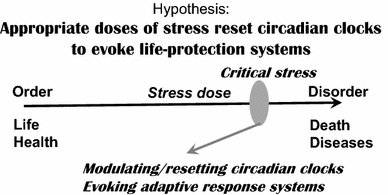Circadian adaptation to cell injury stresses: a crucial interplay of BMAL1 and HSF1
- PMID: 26910317
- PMCID: PMC10717996
- DOI: 10.1007/s12576-016-0436-5
Circadian adaptation to cell injury stresses: a crucial interplay of BMAL1 and HSF1
Abstract
The circadian clock system confers daily anticipatory physiological processes with the ability to be reset by environmental cues. This "circadian adaptation system" (CAS), driven by cell-autonomous molecular clocks, orchestrates various rhythmic physiological processes in the entire body. Hence, the dysfunction of these clocks exacerbates various diseases, which may partially be due to the impairment of protective pathways. If this is the case, how does the CAS respond to cell injury stresses that are critical in maintaining health and life by evoking protective pathways? To address this question, here we review and discuss recent evidence revealing life-protective (pro-survival) molecular networks between clock (e.g., BMAL1, CLOCK, and PER2) and adaptation (e.g., HSF1, Nrf2, NF-κB, and p53) pathways, which are evoked by various cell injury stresses (e.g., heat, reactive oxygen species, and UV). The CK2 protein kinase-integrated interplay of the BMAL1 (clock) and HSF1 (heat-shock response) pathways is one of the crucial events in CAS.
Keywords: Adaptation; Circadian clock; Heat shock; Oxidative stress; Protein kinase.
Figures
Similar articles
-
Circadian modification network of a core clock driver BMAL1 to harmonize physiology from brain to peripheral tissues.Neurochem Int. 2018 Oct;119:11-16. doi: 10.1016/j.neuint.2017.12.013. Epub 2018 Jan 3. Neurochem Int. 2018. PMID: 29305918 Review.
-
ROS stress resets circadian clocks to coordinate pro-survival signals.PLoS One. 2013 Dec 2;8(12):e82006. doi: 10.1371/journal.pone.0082006. eCollection 2013. PLoS One. 2013. PMID: 24312621 Free PMC article.
-
Synchronization of circadian Per2 rhythms and HSF1-BMAL1:CLOCK interaction in mouse fibroblasts after short-term heat shock pulse.PLoS One. 2011;6(9):e24521. doi: 10.1371/journal.pone.0024521. Epub 2011 Sep 7. PLoS One. 2011. PMID: 21915348 Free PMC article.
-
Bmal1 and β-cell clock are required for adaptation to circadian disruption, and their loss of function leads to oxidative stress-induced β-cell failure in mice.Mol Cell Biol. 2013 Jun;33(11):2327-38. doi: 10.1128/MCB.01421-12. Epub 2013 Apr 1. Mol Cell Biol. 2013. PMID: 23547261 Free PMC article.
-
Effects of BMAL1 Manipulation on the Brain's Master Circadian Clock and Behavior.Yale J Biol Med. 2019 Jun 27;92(2):251-258. eCollection 2019 Jun. Yale J Biol Med. 2019. PMID: 31249486 Free PMC article. Review.
Cited by
-
Comprehensive RNA-Seq Profiling Reveals Temporal and Tissue-Specific Changes in Gene Expression in Sprague-Dawley Rats as Response to Heat Stress Challenges.Front Genet. 2021 Apr 9;12:651979. doi: 10.3389/fgene.2021.651979. eCollection 2021. Front Genet. 2021. PMID: 33897767 Free PMC article.
-
Cooperative interaction among BMAL1, HSF1, and p53 protects mammalian cells from UV stress.Commun Biol. 2018 Nov 22;1:204. doi: 10.1038/s42003-018-0209-1. eCollection 2018. Commun Biol. 2018. PMID: 30480104 Free PMC article.
-
The hidden rhythms of epilepsy: exploring biological clocks and epileptic seizure dynamics.Acta Epileptol. 2025 Jan 3;7(1):1. doi: 10.1186/s42494-024-00197-w. Acta Epileptol. 2025. PMID: 40217344 Free PMC article. Review.
-
Emerging Insight Into the Role of Circadian Clock Gene BMAL1 in Cellular Senescence.Front Endocrinol (Lausanne). 2022 Jun 6;13:915139. doi: 10.3389/fendo.2022.915139. eCollection 2022. Front Endocrinol (Lausanne). 2022. PMID: 35733785 Free PMC article. Review.
-
Role of circadian rhythms in pathogenesis of acute CNS injuries: Insights from experimental studies.Exp Neurol. 2022 Jul;353:114080. doi: 10.1016/j.expneurol.2022.114080. Epub 2022 Apr 9. Exp Neurol. 2022. PMID: 35405120 Free PMC article. Review.
References
-
- Ikeda M, Nomura M. cDNA cloning and tissue-specific expression of a novel basic helix-loop-helix/PAS protein (BMAL1) and identification of alternatively spliced variants with alternative translation initiation site usage. Biochem Biophys Res Commun. 1997;233:258–264. doi: 10.1006/bbrc.1997.6371. - DOI - PubMed
Publication types
MeSH terms
Substances
LinkOut - more resources
Full Text Sources
Other Literature Sources
Research Materials
Miscellaneous



